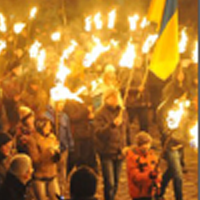
Social Dynamics
Reminiscence of WWII Sets the Pace in the Ukraine Crisis
by Marc-André Cotton*—Int. Psychohistorical Association
This article was published in Clio’s Psyche, Volume 21, No 3, December 2014.
Abstract: The intergenerational transmission of unresolved family grief can be a root cause of tragic reenactments in public affairs. In relation to the Ukraine crisis, a better understanding of such mechanism would bring a peaceful conclusion.

The conflict raging in Eastern Ukraine showed a dramatic evolution with the downing of Malaysian Airlines flight MH17 that killed 298 people, including 80 children, last July. The two warring parties immediately accused one another. This tragedy proved that pro-Russian separatists were “barbarians” in the eyes of Ukrainian authorities on one hand and the victims of a “Machiavellian plot” for those of self-declared republic of Donetsk on the other hand (Courrier international, No 1238, 7/24/2014). The Obama administration then declared Putin “culpable” of the plane crash and imposed further sanctions on Moscow, an escalation reminiscent of the Cold War.
Feeling victimized
This rhetoric shows a common willingness to put blame on the adversary so as to justify military operations against the “enemy”—thereby rejecting any responsibility in the mise-en scène. In this context, Ukrainian forces and rebel separatists blame each other for the atrocities committed in the Eastern Donbass area where thousands have been killed.
Such a compulsive reaction is a psychological defense mechanism projecting on an external cause the sequel of traumatic events experienced in the past. While locating the source of one’s suffering out of oneself, we can avoid re-experiencing the painful repressed emotions associated with the original trauma.
Undoubtedly, this tendency to feel victimized stems from a background of punitive parenting in childhood. However, this defense mechanism can also ensnare adults in tragic re-enactment in which they assume the role of “persecutor” by their deeds or tacit consent—as seen in the Ukraine crisis and many other political conflicts.
In November 2013, Kiev’s Independence Square witnessed violent confrontations after the rejection of an association agreement with the European Union (EU) by former pro-Russian president Viktor Yanukovych. After Yanukovych’s dismissal, the new parliament rushed to remove the official status of the Russian language within 13 of the 27 jurisdictions of Ukraine, ultimately leading to secession of the Russian-speaking republic of Crimea. Other eastern republics soon declared independence and took arms, triggering an ongoing cycle of violence.
Reminiscence of WWII traumas
These events have apparently stimulated traumas associated with World War II. The Russian media regularly refer to the “fascists” who took power in Kiev, while Ukrainian authorities accuse Moscow-sponsored separatists of being “terrorists committing crimes against humanity” in Ukraine (Le Monde, 07/23/2014). Unresolved grief of the war period could explain why protagonists worship the memory of traumatic events that have become symbols of a restored identity on both sides.
Though it appears overstated to blame as “fascists” all western Ukrainians favoring of a rapprochement with the EU, it cannot be disputed that some of them are fanatics revering Nazis-allied ancestors. At the time, 250,000 Ukrainian nationalists were trained by the Wehrmacht and took part with the Germans in the extermination of Jews, gypsies and communists.
Not only were these crimes never prosecuted, but the Kiev government also authorizes neo-Nazi groups to parade during supposedly patriotic celebrations. In January 2014, for instance, chief of the right-wing Svoboda Party led a torched-lit parade through the streets of Kiev in honor of fascist leader Stepan Bander, the most radical of Ukrainian nationalist and collaborator with Hitler[1].
A decade before the war, forced collectivization of rural areas by the Soviets and Stalin’s terror campaign caused a major famine that claimed millions of Ukrainian victims. Historian Omelian Roudnitsky recalls: “It was apocalypse. In this kind of collective farm (kolkhozian) ghetto without access to the outside world, all food supplies had been confiscated. There were acts of cannibalism on children[2].”
In 2006, the parliament in Kiev formally denounced the genocidal nature of this artificial famine and morphed the tragedy—now commonly known as the Holodomor (“killing by hunger”)—into a touchstone of national identity. Moscow criticized Holodomor as a politically motivated act, arguing that other ethnic groups had also endured dire food shortages and that collectivization didn’t target Ukrainians, but mainly the layer of better-off peasants known as kulaks. For its part, the European parliament acknowledged the Holodomor “as an appalling crime against the Ukrainian people, and against humanity” without using the term genocide[3].
So on the one hand, Ukrainian nationalists are claiming to exist as a people freed from Russian domination while pro-Russian Ukrainians see Kiev’s movement to the West as a repudiation of the country’s historic ties to Russia[4]. But is this just a political issue or are there deeper motivations at play?
Intergenerational transmission of violence
In their respective books, psychotherapists Alice Miller and her son Martin Miller contribute to a better understanding of how childhood traumas are transmitted to the next generation through the reenactment of past violence. As we know, the first author focused on the innocence of children and on the unwitting allegiance they pay to their former persecutors’ thinking patterns. By reconsidering their painful mother and son relationship in a very recent book, the second shows how the abuse endured by young Alicia within a Polish family of orthodox Jewish obedience, and then in the turmoil of the Nazi occupation, led to the neglect of her own child Martin who came to experience similar sentiments of despair.
In Martin Miller’s book “The True ‘Drama of the Gifted Child.’ The Tragedy of Alice Miller—How Repressed War Traumas Impact Families”, currently available in German and French, Alice Miller acknowledges that she projected onto her husband Andreas the sensation of being “trapped and continuously monitored” that engulfed her during war-time in Warsaw, as a blackmailer threatened to reveal her Jewish identity to the Nazi occupiers[5]. Seeking “scapegoats”–in this case a husband she didn’t love—was a means to cope with her traumatic past, as well as part of an insightful self-analysis dedicated to unveiling the adverse impact of childrearing violence on our daily lives and on society as a whole. This was a standpoint she developed in her groundbreaking works.
Thus, cruel as it might seem, the painful dynamics of reenactment can be viewed as an expression of our human nature seeking a growing consciousness. It holds an “unconscious grammar” by which our inner selves take precedence and disclose machinations that nearly led to their annihilation. That is possibly why our re-stagings sometimes call upon the world to act as a witness and why we shamelessly lure our children into them.
In the Ukraine, intergenerational transmission of violence is rampant. In a recent assessment, the Committee on the Rights of the Child (CRC) expressed concern about “reports of widespread use of corporal punishment in the home” despite a general prohibition since 2001, and worried about “the low level of awareness” of the public[6]. The latest statistics from UNICEF show that 61.2% of children aged 2-14 years are subjected to physical or psychological punishment by adults[7]. Non-governmental organizations (NGOs) charge that torture and ill-treatment of children and teenagers are widespread in the juvenile justice system too[8].
Persistence of such “educational” practices is partly due to the influence of a popular religiosity largely unchallenged even under communism because it supported social authority. The Soviet regime encouraged families to leave their children in the care of state institutions to pursue their ideological indoctrination. The same model applies today to disabled or socially maladjusted children who form the vast majority of juveniles growing up in orphanages where they were abandoned by their parents. Ukrainian society ostracizes these “children of the devil”—as they are called using a Biblical term—who are confined to state institutions where they are abused in isolation from the rest of the world.
Such a mixture of helplessness and repressed rage makes the western Ukraine population particularly vulnerable to messages of hatred voiced by nationalists. While displacing their frustration on an easy target—in this case the Russian-speaking minority blamed for the current social unrest—people deprive themselves of a possible healing, which requires a long-term trauma processing. Indeed, as in other parts of the world currently in conflict, this might well be the only therapeutic option able to silence the clash of arms.
Marc-André Cotton*
© M.A. Cotton – 11.2014 / regardconscient.net
*Marc-André Cotton, MA, the President of the International Psychohistorical Association, and an International Member of the Psychohistory Forum, is a teacher, independent scholar, and director of the French website Regard conscient, dedicated to exploring the unconscious motivations of human behavior. He authored the French psychohistorical book Au Nom du père, les années Bush et l’héritage de la violence éducative published in 2014 by L’Instant présent (Paris).
Notes :
[1] Robert Thurston, “Ukraine’s Toxic History of Fascism and Ethnic Cleansing”, History News Network, March 5, 2014.
[2] Omelian Roudnitsky, quoted by Piotr Smolar, « L’Ukraine donne une dimension politique à la commémoration de la famine des années 1930 », Le Monde, November 19, 2008.
[3] “European Parliament resolution of 23 October 2008 on the commemoration of the Holodomor, the Ukraine artificial famine (1932-1933)”, European Parliament, October 23, 2008.
[4] On this topic, read Bernard De Backer, « Ukraine. Holodomor, les enjeux d’une reconnaissance tardive », La Revue Nouvelle, December 2008, No 12.
[5] Martin Miller, Le vrai “drame de l’enfant doué”, la tragédie d’Alice Miller ou l’effet des traumatismes de guerre dans la famille, Presse universitaires de France, 2013, p. 78. Therapist Barbara Rogers has written a moving review of this book. Read “Alice Miller's true self would have supported her son with this difficult book”, Scream from Childhood, October 2013.
[6] Global Initiative to End All Corporal Punishment of Children, Country Report, Ukraine, March 2013.
[7] UNICEF – Multiple Indicator Cluster Survey 2012, UNICEF, August 2012, p. 11.
[8] See in particular Torture and Ill-Treatment of Children in Conflict with the Law in Ukraine, Kharciv Human Rights Protection Group, 2012.
